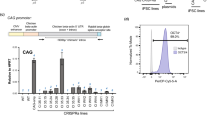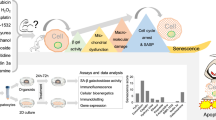Abstract
Background
Although hepatocellular carcinoma cells can sometimes undergo differentiation in an embryonic microenvironment, the mechanism is poorly understood.
Aim
The developmental stage-specific embryonic induction of tumor cell differentiation was investigated.
Methods
Both chick and mouse liver extracts and hepatoblast-enriched cells at different developmental stages were used to treat human hepatoma HepG2 cells, and the effects on the induction of differentiation were evaluated. The nuclear factors controlling differentiation, hepatocyte nuclear factor (HNF)-4α, HNF-1α, HNF-6 and upstream stimulatory factor-1 (USF-1), and the oncogene Myc and alpha-fetoprotein (AFP) were measured. HNF-4α RNA interference was used to verify the role of HNF-4α. Embryonic induction effects were further tested in vivo by injecting HepG2 tumor cells into immunodeficient nude mice.
Results
The 9–11-days chick liver extracts and 13.5–14.5-days mouse hepatoblast-enriched cells could inhibit proliferation and induce differentiation of HepG2 cells, leading to either death or maturation to hepatocytes. The maturation of surviving HepG2 cells was confirmed by increases in the expressions of HNF-4α, HNF-1α, HNF-6, and USF-1, and decreases in Myc and AFP. The embryonic induction of HepG2 cell maturation could be attenuated by HNF-4α RNA interference. Furthermore, the 13.5-days mouse hepatoblast culture completely eliminated HepG2 tumors with inhibited Myc and induced HNF-4α, confirming this embryonic induction effect in vivo.
Conclusions
This study demonstrated that developmental stage-specific embryonic induction of HepG2 cell differentiation might help in understanding embryonic differentiation and oncogenesis.









Similar content being viewed by others
References
Yong KJ, Gao C, Lim JS, et al. Oncofetal gene SALL4 in aggressive hepatocellular carcinoma. N Engl J Med. 2013;368:2266–2276.
Huang X, Liu F, Zhu C, et al. Suppression of KIF3B expression inhibits human hepatocellular carcinoma proliferation. Dig Dis Sci. 2014;59:795–806.
Siegel R, Naishadham D, Jemal A. Cancer statistics, 2013. CA Cancer J Clin. 2013;63:11–30.
Yamashita T, Ji J, Budhu A, et al. EpCAM-positive hepatocellular carcinoma cells are tumor-initiating cells with stem/progenitor cell features. Gastroenterology. 2009;136:1012–1024.
Ben-David U, Benvenisty N. The tumorigenicity of human embryonic and induced pluripotent stem cells. Nat Rev Cancer. 2011;11:268–277.
Becker D, Sfakianakis I, Krupp M, et al. Genetic signatures shared in embryonic liver development and liver cancer define prognostically relevant subgroups in HCC. Mol Cancer. 2012;11:55.
Sell S, Nicolini A, Ferrari P, Biava PM. Cancer: a problem of developmental biology; scientific evidence for reprogramming and differentiation therapy. Curr Drug Targets. 2015 [Epub ahead of print].
Biava PM, Nicolini A, Ferrari P, Carpi A, Sell S. A systemic approach to cancer treatment: tumor cell reprogramming focused on endocrine-related cancers. Curr Med Chem. 2014;21:1072–1081.
Joel M, Sandberg CJ, Boulland JL, Vik-Mo EO, Langmoen IA, Glover JC. Inhibition of tumor formation and redirected differentiation of glioblastoma cells in a xenotypic embryonic environment. Dev Dyn. 2013;242:1078–1093.
Hendrix MJ, Seftor EA, Seftor RE, Kasemeier-Kulesa J, Kulesa PM, Postovit LM. Reprogramming metastatic tumour cells with embryonic microenvironments. Nat Rev Cancer. 2007;7:246–255.
Postovit LM, Margaryan NV, Seftor EA, et al. Human embryonic stem cell microenvironment suppresses the tumorigenic phenotype of aggressive cancer cells. Proc Natl Acad Sci USA. 2008;105:4329–4334.
Yu JM, Jun ES, Bae YC, Jung JS. Mesenchymal stem cells derived from human adipose tissues favor tumor cell growth in vivo. Stem Cells Dev. 2008;17:463–473.
Kamino H, Moore R, Negishi M. Role of a novel CAR-induced gene, TUBA8, in hepatocellular carcinoma cell lines. Cancer Genet. 2011;204:382–391.
Woo HG, Park ES, Thorgeirsson SS, Kim YJ. Exploring genomic profiles of hepatocellular carcinoma. Mol Carcinog. 2011;50:235–243.
Li T, Huang J, Jiang Y, et al. Multi-stage analysis of gene expression and transcription regulation in C57/B6 mouse liver development. Genomics. 2009;93:235–242.
Nagaki M, Moriwaki H. Transcription factor HNF and hepatocyte differentiation. Hepatol Res. 2008;38:961–969.
Zeng X, Lin Y, Yin C, et al. Recombinant adenovirus carrying the hepatocyte nuclear factor-1alpha gene inhibits hepatocellular carcinoma xenograft growth in mice. Hepatology. 2011;54:2036–2047.
Beaudry JB, Pierreux CE, Hayhurst GP, et al. Threshold levels of hepatocyte nuclear factor 6 (HNF-6) acting in synergy with HNF-4 and PGC-1alpha are required for time-specific gene expression during liver development. Mol Cell Biol. 2006;26:6037–6046.
van Deursen D, van Leeuwen M, Vaulont S, Jansen H, Verhoeven AJ. Upstream Stimulatory Factors 1 and 2 activate the human hepatic lipase promoter via E-box dependent and independent mechanisms. Biochim Biophys Acta. 2009;1791:229–237.
Odom DT, Dowell RD, Jacobsen ES, et al. Core transcriptional regulatory circuitry in human hepatocytes. Mol Syst Biol. 2006;2006:0017.
Guo J, Parise RA, Joseph E, et al. Efficacy, pharmacokinetics, tissue distribution, and metabolism of the Myc-Max disruptor, 10058-F4 [Z, E]-5-[4-ethylbenzylidine]-2-thioxothiazolidin-4-one, in mice. Cancer Chemother Pharmacol. 2009;63:615–625.
Hung TM, Hu RH, Ho CM, et al. Downregulation of alpha-fetoprotein expression by LHX4: a critical role in hepatocarcinogenesis. Carcinogenesis. 2011;32:1815–1823.
Personeni N, Bozzarelli S, Pressiani T, et al. Usefulness of alpha-fetoprotein response in patients treated with sorafenib for advanced hepatocellular carcinoma. J Hepatol. 2012;57:101–107.
Yin C, Lin Y, Zhang X, et al. Differentiation therapy of hepatocellular carcinoma in mice with recombinant adenovirus carrying hepatocyte nuclear factor-4alpha gene. Hepatology. 2008;48:1528–1539.
Walesky C, Edwards G, Borude P, et al. Hepatocyte nuclear factor 4 alpha deletion promotes diethylnitrosamine-induced hepatocellular carcinoma in rodents. Hepatology. 2013;57:2480–2490.
Li Y, Liu D, Liu Y, et al. Protein nitration promotes inducible nitric oxide synthase transcription mediated by NF-κB in high glucose-stimulated human lens epithelial cells. Mol Cell Endocrinol. 2013;370:78–86.
Hebbard L, Cecena G, Golas J, et al. Control of mammary tumor differentiation by SKI-606 (bosutinib). Oncogene. 2011;30:301–312.
Cruz FD, Matushansky I. Solid tumor differentiation therapy—is it possible? Oncotarget. 2012;3:559–567.
Campos B, Wan F, Farhadi M, et al. Differentiation therapy exerts antitumor effects on stem-like glioma cells. Clin Cancer Res. 2010;16:2715–2728.
Zhang Y, Guan DX, Shi J, et al. All-trans retinoic acid potentiates the chemotherapeutic effect of Cisplatin by inducing differentiation of tumor initiating cells in liver cancer. J Hepatol. 2013;59:1255–1263.
Postovit LM, Seftor EA, Seftor RE, Hendrix MJ. A three-dimensional model to study the epigenetic effects induced by the microenvironment of human embryonic stem cells. Stem Cells. 2006;24:501–505.
Ingber DE. Can cancer be reversed by engineering the tumor microenvironment? Semin Cancer Biol. 2008;18:356–364.
Nakayama M, Matsumoto K, Tatsumi N, Yanai M, Yokouchi Y. Id3 is important for proliferation and differentiation of the hepatoblasts during the chick liver development. Mech Dev. 2006;123:580–590.
Duncan SA. Mechanisms controlling early development of the liver. Mech Dev. 2003;120:19–33.
Lemaigre F, Zaret KS. Liver development update: new embryo models, cell lineage control, and morphogenesis. Curr Opin Genet Dev. 2004;14:582–590.
Zaret KS, Grompe M. Generation and regeneration of cells of the liver and pancreas. Science. 2008;322:1490–1494.
Hatziapostolou M, Polytarchou C, Aggelidou E, et al. An HNF4α-miRNA inflammatory feedback circuit regulates hepatocellular oncogenesis. Cell. 2011;147:1233–1247.
Takayama K, Inamura M, Kawabata K, et al. Efficient generation of functional hepatocytes from human embryonic stem cells and induced pluripotent stem cells by HNF4α transduction. Mol Ther. 2012;20:127–137.
Biava PM, Basevi M, Biggiero L, Borgonovo A, Borgonovo E, Burigana F. Cancer cell reprogramming: stem cell differentiation stage factors and an agent based model to optimize cancer treatment. Curr Pharm Biotechnol. 2011;12:231–242.
Acknowledgments
This work was supported by the National Natural Science Foundation of China (81470595) and the Hebei Natural Science Foundation (H2015206101).
Author information
Authors and Affiliations
Corresponding author
Ethics declarations
Conflict of interest
None.
Additional information
Yanning Li and Yanhong Zong contributed equally to this work.
Electronic supplementary material
Below is the link to the electronic supplementary material.
10620_2015_3966_MOESM1_ESM.tif
Supplemental Fig. 1 Mouse primary hepatoblasts. Albumin was found in nearly all cells, indicating that they were hepatoblast-enriched cells. Scale bar = 30 μm (TIF 957 kb)
Rights and permissions
About this article
Cite this article
Li, Y., Zong, Y., Xiao, Z. et al. Developmental Stage-Specific Embryonic Induction of HepG2 Cell Differentiation. Dig Dis Sci 61, 1098–1106 (2016). https://doi.org/10.1007/s10620-015-3966-4
Received:
Accepted:
Published:
Issue Date:
DOI: https://doi.org/10.1007/s10620-015-3966-4




